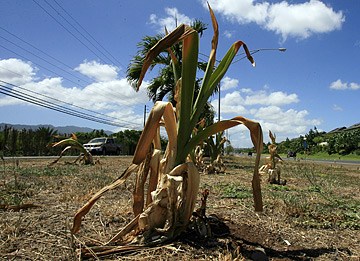
|
Kokua Line
June Watanabe
|
Fort Weaver Road irrigation due next year
Question: What has happened to the irrigation system along Fort Weaver Road between Aawa Drive (West Loch Fairways) and Geiger Road? I've noticed that there are broken sprinkler fixtures along the length of the highway, and, sadly, all the plantings done several years ago are dying, including the grass.
Answer: We answered a similar question in 2003, when dying plants in the median along Fort Weaver Road were attributed to a broken sprinkler system and because a landscaping contract had lapsed.
This time, we're told, the irrigation system is "not fully functional" and needs to be replaced. But that won't happen until early next year.
About 450 trees and 4,000 shrubs were planted in 1998 as part of the original landscaping there, at a cost of nearly $990,000, said Scott Ishikawa, spokesman for the state Department of Transportation.
With a continuing water shortage, "the plants are expected to struggle but survive," he said.
The basic problem is the original landscaping equipment was designed to use potable water, Ishikawa explained.

JAMM AQUINO / JAQUINO@STARBULLETIN.COM
These plants on the median separating north- and southbound traffic along Fort Weaver Road are nearly dried out.
|
|
But as housing developments sprouted along the Ewa Plains in recent years, demands for potable water increased. At the same time, the Board of Water Supply called for conserving water.
The regional water supply has remained the same, Ishikawa noted, but the Department of Transportation "has received less and less water as developments have continued to grow."
That prompted the department to retrofit the existing irrigation system in 2004 to work with nonpotable water provided by the Board of Water Supply, he said.
However, the Honouliuli Wastewater Treatment Plant could not consistently produce enough recycled water to meet landscaping demands, Ishikawa said.
Meanwhile, nonpotable water requires different types of valves, sprinkler heads, etc., he said, so the existing irrigation equipment, in trying to get enough water pressure, would often malfunction.
The Board of Water Supply "is trying to rectify the shortage of nonpotable water in the Ewa region, but until additional resources are provided, it is expected that the water pressure will not be sufficient for adequate watering," Ishikawa said.
Phase II of the Fort Weaver Road Widening Project includes replacing the landscaping system with one designed for use with nonpotable water early next year.
Harano Tunnels
Yoshie Tanabe, who spurred the fight to restore the name Tetsuo Harano to the state's H-3 tunnel, wants readers to know that the name of the retired state highways administrator is now in full public view above the tunnel entrances.
On July 21, "a car from the Department Transportation drove Mr. and Mrs. Tetsuo Harano to behold the Tetsuo Harano Tunnel signs," she told us.
There was no public fanfare about the unveiling of the new sign.
The state Legislature, by concurrent resolution in 1994, agreed that the tunnels should be named after Harano, who worked for the Transportation Department for 52 years. However, former Gov. Ben Cayetano, by executive order in 2001, renamed the tunnels after the late Gov. John Burns, saying Burns was more deserving of the honor.
Harano's name instead was given to the H-3's control center.
After "Kokua Line" reported on April 2, 2002, that Harano had been hurt by Cayetano's decision, Tanabe, a retired Waipio Gentry resident, launched a petition drive to restore his name to the tunnel.
Others joined her crusade, including Kongo Kimura, who contacted Linda Lingle during her gubernatorial campaign. In 2003, after Lingle was elected governor, she fulfilled her promise to restore Harano's name to the tunnel.
However, while Burns' name was placed in large letters over the tunnel entrances, Harano's name was affixed to its original spot. Tanabe described it as a sign with "dull letters on the gray concrete between the tunnels" that most people driving by at 55 mph would not see.
Since 2003 she has been demanding that the Department of Transportation put Harano's name "where everyone could see it."
"I kept on writing and calling and received 'reasons' after 'reasons'" why the bigger sign never went up, she said, until she received a call on July 3 informing her that the sign would be installed July 14.
Transportation spokesman Scott Ishikawa acknowledged that the efforts of Tanabe and others "led to the letters above the tunnel portals."
He also noted a letter to the editor in Friday's Star-Bulletin, which decried the use of "cheap-looking material" for the new lettering. The writer said Harano deserved as much as Burns, whose name was spelled out in "shiny brass letters."
Ishikawa said copper letters were used for the Burns name, and it was a matter of costs when it came time to mount Harano's name.
Copper letters would have cost an additional $40,000 to install, he said. Because it tarnishes from the elements, it also would need more maintenance over time than the $12,000 aluminum letters chosen, he said.
The aluminum letters have a protective coating that requires little maintenance, he said, adding, "We believe Mr. Harano would want us to keep the maintenance costs down on his tunnel name."
Additionally, the aluminum letters "are much, much lighter than the copper ones," Ishikawa said, thus potentially causing less damage in the event they fell because of a natural disaster.
Meanwhile, Tanabe said that her only wish is that, from her experience, people will know to not give up a battle and to "participate in government."
Got a question or complaint? Call 529-4773, fax 529-4750, or write to Kokua Line, Honolulu Star-Bulletin, 500 Ala Moana Blvd., No. 7-210, Honolulu 96813. As many as possible will be answered. E-mail to
kokualine@starbulletin.com.
See also: Useful phone numbers

